Diagnostics Task and Finish Group Report - 18 Weeks
Diagnostics Task and Finish Group Report - 18 Weeks
Diagnostics Task and Finish Group Report - 18 Weeks
You also want an ePaper? Increase the reach of your titles
YUMPU automatically turns print PDFs into web optimized ePapers that Google loves.
<strong>Diagnostics</strong> <strong>Task</strong> <strong>and</strong> <strong>Finish</strong> <strong>Group</strong> <strong>Report</strong><strong>18</strong> <strong>Weeks</strong> Referral to Treatment St<strong>and</strong>ardDecember 2011Version 1.0
Document ControlPreparedbyDateAccess Support Team, Scottish Government Health Delivery Directorate.5 December 2011Version ControlVersion Date Change Author1.0 5 December 2011 No previous version<strong>Diagnostics</strong> <strong>Task</strong> <strong>and</strong> <strong>Finish</strong> <strong>Group</strong> <strong>Report</strong> - V1.0 December 20112
ContentsIntroduction ........................................................................................................................4Context ..............................................................................................................................8<strong>Diagnostics</strong> <strong>Task</strong> <strong>and</strong> <strong>Finish</strong> <strong>Group</strong> .................................................................................10<strong>Diagnostics</strong>’ Waiting Times..............................................................................................12Diagnostic Waiting Times’ Progress ................................................................................14Mapping of Tests Within Patient Pathways......................................................................<strong>18</strong>Appendix One: Membership of the Diagnostic <strong>Task</strong> <strong>and</strong> <strong>Finish</strong> <strong>Group</strong>............................27Appendix Two: Other Tests .............................................................................................28Appendix Three: Good Practice Examples ......................................................................32<strong>Diagnostics</strong> <strong>Task</strong> <strong>and</strong> <strong>Finish</strong> <strong>Group</strong> <strong>Report</strong> - V1.0 December 20113
IntroductionForeword <strong>and</strong> CommendationsThe work of the <strong>Diagnostics</strong> <strong>Task</strong> <strong>and</strong> <strong>Finish</strong> <strong>Group</strong> is sponsored by the ScottishGovernment’s <strong>18</strong> <strong>Weeks</strong> Referral to Treatment Operational Delivery Team, <strong>and</strong>ultimately by the Scottish Government’s Health Delivery Directorate. The <strong>Task</strong> <strong>and</strong><strong>Finish</strong> <strong>Group</strong> has, from a national perspective, considered how to manage identified risksin the delivery <strong>and</strong> reporting of diagnostic tests within the context of the <strong>18</strong> <strong>Weeks</strong> RTTSt<strong>and</strong>ard <strong>and</strong> this report details examples of this work.The core elements of this report are commended to you by the Operational DeliveryTeam for action. Every Board is expected to ensure that each aspect is fully explored,progressed <strong>and</strong> embedded appropriately across their Health Community to support timely<strong>and</strong> high quality patient care. It is essential that all opportunities for streamlined servicemanagement <strong>and</strong> ongoing improvement <strong>and</strong> transformation are optimised, with thepatient’s interest right at the centre. Delivery <strong>and</strong> improvement require whole systemsownership <strong>and</strong> strong organisational leadership – both clinical <strong>and</strong> managerial – in orderto embed <strong>and</strong> operationalise change on a sustainable basis.The core elements commended to Health Communities <strong>and</strong> NHS Boards for action:1. Ensure that Diagnostic Tests are embedded in Boards’ delivery plans, <strong>and</strong> identifythose tests which impact on patient pathways <strong>and</strong> consequently the delivery of <strong>18</strong><strong>Weeks</strong> RTT St<strong>and</strong>ard.2. Use available IT systems to capture <strong>and</strong> record clock starts/stops for diagnostictests. This will enable diagnostic services to manage waiting lists <strong>and</strong> providedetailed information which can be used for capacity <strong>and</strong> dem<strong>and</strong> planning.3. Proactively promote detailed capacity planning in order to match capacity withdem<strong>and</strong>, paying particular attention to underst<strong>and</strong>ing <strong>and</strong> then managing referralvariations, especially in relation to the key diagnostic tests.4. Utilise good practice examples to facilitate focused service redesign <strong>and</strong> pathwaywork, including opportunities for direct access to diagnostic services. Examples ofgood practice within Diagnostic Services will be published as case studies on theQuality Improvement Hub at www.qihub.scot.nhs.uk.<strong>Diagnostics</strong> <strong>Task</strong> <strong>and</strong> <strong>Finish</strong> <strong>Group</strong> <strong>Report</strong> - V1.0 December 20114
Should performance with the timely delivery <strong>and</strong> reporting of <strong>Diagnostics</strong> Tests proveunsatisfactory, the escalation process triggered by the Scottish Government couldinclude further action planning with the Access <strong>and</strong> Improvement Support Teams, moredetailed tailored support or intervention as needed, together with submission of detailedrecovery plans.Robert CalderwoodChair of the Operational Delivery Team<strong>Diagnostics</strong> <strong>Task</strong> <strong>and</strong> <strong>Finish</strong> <strong>Group</strong> <strong>Report</strong> - V1.0 December 20115
Chair’s ReflectionsI was pleased to be invited to chair the <strong>Task</strong> <strong>and</strong> <strong>Finish</strong> <strong>Group</strong> for Diagnostic Services,commissioned by the Operational Delivery Team of the <strong>18</strong> <strong>Weeks</strong> RTT Programme. Therationale for forming this <strong>Group</strong> was the high volume of referrals for diagnostic testsacross a wide range of services with the potential to impact on the delivery of seamlesscare within patient pathways, <strong>and</strong> ultimately pose a significant risk to the delivery <strong>and</strong>maintenance of the <strong>18</strong> <strong>Weeks</strong> RTT across many specialties. The Diagnostic <strong>Task</strong> <strong>and</strong><strong>Finish</strong> <strong>Group</strong> was formed to address the key factors impeding delivery of the <strong>18</strong> weeksRTT, to maintain momentum, tackle identified bottlenecks <strong>and</strong> commend critical actionsto the service.Ensuring Diagnostic Services are delivered <strong>and</strong> reported seamlessly is fundamental toachieving <strong>and</strong> maintaining the <strong>18</strong> <strong>Weeks</strong> RTT St<strong>and</strong>ard. In order to facilitate thisprocess, it is paramount that information systems are fully exploited across a whole rangeof tests, particularly those that are integral to <strong>18</strong> weeks pathways, in order to maximiseefficiency of process. As well as ensuring diagnostics are linked to waiting timessystems, there is a need for systems to support clinical outcome recording. This will helpto ensure there are no delays in patients progressing to the next stage of a pathway.In t<strong>and</strong>em with this, it is essential that Boards undertake detailed Dem<strong>and</strong>, Capacity,Activity <strong>and</strong> Queue (DCAQ) analysis for diagnostic tests as part of their whole systempathways <strong>and</strong> not in isolation. NHS Boards must ensure that diagnostic tests areembedded within their strategic plans for <strong>18</strong> weeks RTT delivery at December 2011 <strong>and</strong>are subject to performance management processes.Direct Access to diagnostic tests can provide a significant positive effect on the patientjourney <strong>and</strong> many Boards have succeeded in implementing these services to great effect.There are still opportunities for direct access to make a positive impact in other areas <strong>and</strong>this report identifies where there may be possibilities for Boards to explore.Staff across NHSScotl<strong>and</strong> have worked positively <strong>and</strong> innovatively to improve patients’access to diagnostic services <strong>and</strong> this report highlights a range of good practice initiativeswhich have contributed to timely access to these services. Sharing good practice <strong>and</strong><strong>Diagnostics</strong> <strong>Task</strong> <strong>and</strong> <strong>Finish</strong> <strong>Group</strong> <strong>Report</strong> - V1.0 December 20116
linking specialists across NHS Scotl<strong>and</strong> has been the cornerstone of the <strong>Task</strong> & <strong>Finish</strong>process <strong>and</strong> indeed its success. The <strong>Group</strong> has supported the development of aDiagnostic Service Managers’ Network in partnership with the Improvement SupportTeam (IST) to share learning <strong>and</strong> develop capability <strong>and</strong> capacity in waiting listmanagement to enable NHS Boards to deliver the diagnostic element of <strong>18</strong> <strong>Weeks</strong> RTT.I would like to take this opportunity to thank members of the Diagnostic <strong>Task</strong> <strong>and</strong> <strong>Finish</strong><strong>Group</strong>, <strong>and</strong> colleagues from the service who have been involved in these pieces of work,for their commitment <strong>and</strong> valuable advice over the past <strong>18</strong> months, <strong>and</strong> share with youthis report for review <strong>and</strong> implementation in your Board area.Jim CrombieChair of the <strong>Diagnostics</strong>’ <strong>Task</strong> <strong>and</strong> <strong>Finish</strong> <strong>Group</strong><strong>Diagnostics</strong> <strong>Task</strong> <strong>and</strong> <strong>Finish</strong> <strong>Group</strong> <strong>Report</strong> - V1.0 December 20117
ContextThe <strong>18</strong> <strong>Weeks</strong> Referral to Treatment TargetThe Cabinet Secretary for Health <strong>and</strong> Wellbeing has pledged: “a whole journey waitingtime target of <strong>18</strong> <strong>Weeks</strong> from referral to treatment by December 2011.” <strong>18</strong> weeks willtherefore be the maximum wait from receipt of referral into secondary care to firstdefinitive treatment, for non-emergency conditions.The <strong>18</strong> <strong>Weeks</strong> National Delivery StructureIn order to ensure a cohesive approach between the Scottish Government <strong>and</strong> NHSBoards in the delivery of this target, while ensuring maintenance of high quality patientfocussed care, a national delivery approach was established. The <strong>18</strong> <strong>Weeks</strong>’Programme Board oversees the work of four Delivery Teams – focussing on Information,Emergency Access, Operational Issues, <strong>and</strong> <strong>Diagnostics</strong> – which in turn brings a wealthof knowledge, experience <strong>and</strong> expertise to each specialist area.<strong>Task</strong> <strong>and</strong> <strong>Finish</strong> <strong>Group</strong>sAs a consequence of analyses undertaken through the Operational Delivery Team(ODT), a number of <strong>Task</strong> <strong>and</strong> <strong>Finish</strong> <strong>Group</strong>s were formed. The rationale for formingthese short life working groups was to focus on those specialties, at an operational level,identified as posing the greatest risks to the delivery <strong>and</strong> maintenance of the <strong>18</strong> <strong>Weeks</strong>Referral to Treatment (RTT) St<strong>and</strong>ard. Each group was set up with a small number ofclinicians, service managers, GPs <strong>and</strong> additional professionals involved in the specialty,supported by members from the Scottish Government’s Health Delivery Directorate. Thefirst five ‘at risk’ specialties to have <strong>Task</strong> <strong>and</strong> <strong>Finish</strong> <strong>Group</strong>s established were: Audiology,Dental Specialties, Neurological Services, Orthopaedics <strong>and</strong> Plastic Surgery.Subsequently, <strong>Task</strong> <strong>and</strong> <strong>Finish</strong> <strong>Group</strong>s were established in Dermatology, <strong>Diagnostics</strong><strong>and</strong> Dem<strong>and</strong> <strong>and</strong> Capacity Management. All groups have focussed on a series ofcommon work str<strong>and</strong>s, namely:• Measurement <strong>and</strong> Definitions• Dem<strong>and</strong>/Capacity/Activity /Queue Analysis<strong>Diagnostics</strong> <strong>Task</strong> <strong>and</strong> <strong>Finish</strong> <strong>Group</strong> <strong>Report</strong> - V1.0 December 201<strong>18</strong>
• Dem<strong>and</strong> Side Solutions• Performance Management• Service Redesign <strong>and</strong> Transformation• Culture/Change• Workforce• CommunicationThe groups’ reports can be viewed at: http://www.<strong>18</strong>weeks.scot.nhs.uk/how-to-achieve<strong>and</strong>-maintain-<strong>18</strong>-weeks/task-<strong>and</strong>-finish-groups/<strong>Diagnostics</strong> <strong>Task</strong> <strong>and</strong> <strong>Finish</strong> <strong>Group</strong> <strong>Report</strong> - V1.0 December 20119
<strong>Diagnostics</strong> <strong>Task</strong> <strong>and</strong> <strong>Finish</strong> <strong>Group</strong>The <strong>Diagnostics</strong> <strong>Task</strong> <strong>and</strong> <strong>Finish</strong> <strong>Group</strong> held its first meeting in July 2009, withmembership consisting of clinical <strong>and</strong> managerial expertise, to ensure a systematic <strong>and</strong>pragmatic approach could be adopted <strong>and</strong> enable any work undertaken within the groupto be in keeping with patient focused holistic care. Membership is listed at AppendixOne.ObjectivesThe main objectives of the <strong>Diagnostics</strong> <strong>Task</strong> <strong>and</strong> <strong>Finish</strong> group were:• To develop <strong>and</strong> launch the nationally m<strong>and</strong>ated Diagnostic Test MonthlyManagement Information Return (DMMI) data collection exercise to includeproposals for further waiting times information on additional diagnostic tests thatpose a risk to <strong>18</strong> weeks RTT delivery.• To develop a mechanism for regular review of DMMI data to identity risks, proposeactions to address issues, <strong>and</strong> identify <strong>and</strong> share successes.• To assess <strong>and</strong> document the risks to delivery of <strong>18</strong> <strong>Weeks</strong> RTT relating to:o 8 key tests;o 6 additional tests reported through revised DMMI; <strong>and</strong>o all other diagnostic tests.• To provide advice <strong>and</strong> guidance to help ensure that Information Systems support<strong>Diagnostics</strong> <strong>and</strong> the need to meet <strong>18</strong> <strong>Weeks</strong> RTT requirements. In particular that:o Diagnostic Tests can be recorded on systems;o Systems being developed meet the needs of Diagnostic services; <strong>and</strong>o Systems are capable of supporting Clinical Outcome Recording.• To ensure that NHS Boards are recommended a consistent methodology tomeasure, monitor <strong>and</strong> report Dem<strong>and</strong>, Capacity, Activity & Queue (DCAQ) fordiagnostic tests as part of pathway <strong>and</strong> patient flow management.<strong>Diagnostics</strong> <strong>Task</strong> <strong>and</strong> <strong>Finish</strong> <strong>Group</strong> <strong>Report</strong> - V1.0 December 201110
• To undertake a review of Direct Access to Diagnostic Services <strong>and</strong> make availableexamples of Good Practice.• To support the development of a Diagnostic Service Managers’ Network inpartnership with the Improvement <strong>and</strong> Support Team (IST) to share learning <strong>and</strong>develop capability <strong>and</strong> capacity in waiting list management to enable NHS Boardsto deliver the diagnostic element of <strong>18</strong> <strong>Weeks</strong> RTT.• To investigate <strong>and</strong> document issues with Nerve Conduction Studies <strong>and</strong> highlightkey issues <strong>and</strong> recommendations for how these can be addressed, includingidentifying where there is a need for further support.• To liaise with NHS Boards <strong>and</strong> provide ongoing support in reducing waits forDiagnostic Tests through regular interaction, identification of issues <strong>and</strong> promptsto undertake specific actions.<strong>Diagnostics</strong> <strong>Task</strong> <strong>and</strong> <strong>Finish</strong> <strong>Group</strong> <strong>Report</strong> - V1.0 December 201111
<strong>Diagnostics</strong>’ Waiting TimesWhat is a Diagnostic Test?A ‘Diagnostic’ test is a test or procedure that is used to identify a patient’s disease,condition or injury to enable a diagnosis to be made.Diagnostic Tests are a key component of many patient pathways (see section‘Pathways’); failure to promptly report on the results of diagnostic tests mayunnecessarily protract the patient journey.Since 2006, Boards have been submitting Diagnostic Monthly Management Information(DMMI) to the Scottish Government’s Access Support Team on 8 key diagnostic tests,which at that point in time, had anecdotally long waits:• Upper Endoscopy;• Lower Endoscopy;• Colonoscopy;• Cystoscopy;• CT Scan;• MRI Scan;• Barium Studies; <strong>and</strong>• Ultrasound.In February 2008, the ‘<strong>Diagnostics</strong>’ Test <strong>Report</strong>ing; Scoping Study’ identified 213different diagnostic tests which were offered across Scotl<strong>and</strong>. From that list, theDiagnostic <strong>Task</strong> <strong>and</strong> <strong>Finish</strong> <strong>Group</strong> developed the existing DMMI to include waiting timesinformation on a further 6 diagnostic tests which had the potential to pose a particular riskto the delivery of <strong>18</strong> <strong>Weeks</strong> pathways. Following a Chief Executives’ Letter withguidance, a revised DMMI commenced at the end of October 2009 which was collectedas a census snapshot, <strong>and</strong> along with the key diagnostic tests already collected, thefollowing tests were added:• 24 hour ECG <strong>and</strong> 24 hour Blood Pressure;• Echocardiography;<strong>Diagnostics</strong> <strong>Task</strong> <strong>and</strong> <strong>Finish</strong> <strong>Group</strong> <strong>Report</strong> - V1.0 December 201112
• Nerve Conduction Studies;• Sleep Studies; <strong>and</strong>• Spirometry.It is important that Boards ensure they are adhering to the Diagnostic Definitions; themost recent version can be found at:http://www.isdscotl<strong>and</strong>.org/Health-Topics/Waiting-Times/<strong>Diagnostics</strong>/This may assist Boards in terms of eliminating patients who are not on an <strong>18</strong> Weekpathway from the delivery figures.Key Message: Measurement <strong>and</strong> <strong>Report</strong>ing of Diagnostic TestsTo ensure accuracy <strong>and</strong> comparability across NHSScotl<strong>and</strong>, it is important that all Boardsfollow the Diagnostic Definitions Guidance. This can be viewed at:http://www.isdscotl<strong>and</strong>.org/Health-Topics/Waiting-Times/<strong>Diagnostics</strong>/It should also be stressed that measurement should be from referral to report received(not from the date the patient attended for the test).Key Message: <strong>Report</strong>ing of Diagnostic TestsClock stops for Diagnostic waits should only occur once tests results have been reported.<strong>Diagnostics</strong> <strong>Task</strong> <strong>and</strong> <strong>Finish</strong> <strong>Group</strong> <strong>Report</strong> - V1.0 December 201113
Diagnostic Waiting Times’ ProgressSince the DMMI commenced, there have been significant improvements in diagnosticwaiting times across NHSScotl<strong>and</strong>. Figure 1 below shows the reported number ofpatients who waited over 4 <strong>and</strong> 6 weeks for the 8 key tests, from October 2010 toSeptember 2011.Graph 14,0003,500NHS Scotl<strong>and</strong>8 Key Diagnostic TestsNumber of Patients Who Waited Over 6 And 4 weeksTotal 8 Key Tests waits over 4 weeksTotal 8 Key Tests waits over 6 weeks3,0002,5002,0001,5001,0005000Oct-10 Nov-10 Dec-10 Jan-11 Feb-11 Mar-11 Apr-11 May-11 Jun-11 Jul-11 Aug-11 Sep-11Figure 1: Number of Patients Who Waited Over 6 <strong>and</strong> 4 weeks for Key TestsThe rise between October 2010 <strong>and</strong> February 2011 was due to a significant issue inEndoscopy in one particular Board. A recovery plan to address this was implemented<strong>and</strong> this issue has now been resolved. The data for patients who waited over 4 weekscan be viewed by each individual test in Figure 2 below:<strong>Diagnostics</strong> <strong>Task</strong> <strong>and</strong> <strong>Finish</strong> <strong>Group</strong> <strong>Report</strong> - V1.0 December 201114
Graph 2<strong>18</strong>001600140012001000NHS Scotl<strong>and</strong>8 Key Diagnostic TestsNumber of Patients who waited over 4 weeks by TestUpper EndoscopyLower EndocopyColonoscopyCystoscopyCT ScansMRI ScansBarium StudiesUltrasound8006004002000Oct-10 Nov-10 Dec-10 Jan-11 Feb-11 Mar-11 Apr-11 May-11 Jun-11 Jul-11 Aug-11 Sep-11Figure 2: Number of Patients Who Waited Over 4 <strong>Weeks</strong> For Each Key TestThe peak in the number of patients waiting over 4 weeks for an ultrasound test occurredin one Board, which has since been addressed. The Board is continuously <strong>and</strong>proactively working to avoid any further build up of long waiting patients.EndoscopyAlthough Boards are managing, in the main, to keep their waiting times for Endoscopybetween 4-6 weeks, at times this can present a significant challenge. In particular,managing cancer patients within 2 weeks can be difficult. There are also issues aroundsurveillance patients, who are not appropriate to be included in the <strong>18</strong> <strong>Weeks</strong> RTTSt<strong>and</strong>ard as they are on a much longer recall programme, however, they do require to beseen within a defined clinically appropriate timeframe <strong>and</strong> it is important that clinicalpriorities are not distorted due to waiting times st<strong>and</strong>ards. This particular issue is beingdiscussed with the Cancer Strategy Team <strong>and</strong> a Colonoscopy short Life Working <strong>Group</strong>has been formed to undertake a national piece of work around this.Extended DMMIIn terms of the improvement in waiting times for the 6 additional tests, Figure 3 belowshows that this is still a significant challenge, however, good progress has been made.Individual performance by test can be seen in Figure 4.<strong>Diagnostics</strong> <strong>Task</strong> <strong>and</strong> <strong>Finish</strong> <strong>Group</strong> <strong>Report</strong> - V1.0 December 201115
Figure 3: Number of Patients Who Waited Over 6 <strong>and</strong> 4 <strong>Weeks</strong> for Additional 6 TestsGraph 36000NHS Scotl<strong>and</strong>Additional Diagnostic TestsNumber of patients who waited over 6 <strong>and</strong> 4 weeks5000Total Additional Tests waiting over 4 weeksTotal Additional Tests waiting over 6 weeks40003000200010000Oct-10 Nov-10 Dec-10 Jan-11 Feb-11 Mar-11 Apr-11 May-11 Jun-11 Jul-11 Aug-11 Sep-11Figure 4: Number of Patients Who Waited Over 4 <strong>Weeks</strong> For an Additional Test (from 6 reported)NHS Scotl<strong>and</strong>Additional Diagnostic TestsNumber of patients who waited over 4 weeks250020001500ECGBlood PressureEchocardiographyNerve Conduction StudiesSleep StudiesSpirometry10005000Sep-10 Oct-10 Nov-10 Dec-10 Jan-11 Feb-11 Mar-11 Apr-11 May-11 Jun-11 Jul-11 Aug-11Figure 4 shows the impact of focused improvement efforts, where sites providing nerveconduction studies have made significant inroads to reducing waits.<strong>Diagnostics</strong> <strong>Task</strong> <strong>and</strong> <strong>Finish</strong> <strong>Group</strong> <strong>Report</strong> - V1.0 December 201116
From the reported figures for echocardiography, it would appear that a significantdecrease in waiting times has occurred across NHSScotl<strong>and</strong> between Sep 2010 <strong>and</strong> Aug2011, however, this may be due to improved accuracy in the reporting process <strong>and</strong>therefore may not be as significant as it might appear.There are of course a huge number of diagnostic tests not reported in the DMMI thatcould impact on the delivery of <strong>18</strong> <strong>Weeks</strong> RTT. A list of identified tests is at AppendixTwo although this list is not exhaustive.<strong>Diagnostics</strong> <strong>Task</strong> <strong>and</strong> <strong>Finish</strong> <strong>Group</strong> <strong>Report</strong> - V1.0 December 201117
Mapping of Tests Within Patient PathwaysA lack of data availability for all other diagnostic tests prevents assessment of waitingtimes in other areas <strong>and</strong> comparison across Boards. Boards are encouraged to improverecording of waits for diagnostic tests to ensure that the discipline of rigorous waiting listmanagement is applied to these areas. This will also enable risk assessment of theimpact of waits in these areas on overall <strong>18</strong> <strong>Weeks</strong> pathways <strong>and</strong> will allow local teamsto target improvement accordingly. Many Boards have now taken steps to improve theadministration of all other diagnostic tests, traditionally managed through paper systems,onto core Patient Administration Systems; this is commended to other Boards.Key Message: Data CaptureBoards should have technical solutions to incorporate Diagnostic Tests within their <strong>18</strong><strong>Weeks</strong> <strong>Report</strong>ing Systems; ensuring clock stops occurring as a result of the outcome of adiagnostic test are captured.Key Message: Risk Management around Diagnostic TestsWhat is important now is to look at which <strong>18</strong> <strong>Weeks</strong> RTT pathways these diagnostic testseffect, what risk they might potentially pose to delivery, <strong>and</strong> whether there are elementswithin those pathways that require improvement focus.Capacity <strong>and</strong> Dem<strong>and</strong> ManagementA significant amount of work has been undertaken within NHS Boards to underst<strong>and</strong>Dem<strong>and</strong>, Capacity, Activity <strong>and</strong> Queue (DCAQ) for the 8 key diagnostic tests. This workwas led through the <strong>Diagnostics</strong> Collaborative between 2006 <strong>and</strong> 2008. The <strong>Diagnostics</strong><strong>Task</strong> <strong>and</strong> <strong>Finish</strong> <strong>Group</strong> have worked with colleagues from the Improvement <strong>and</strong> SupportTeam <strong>and</strong> local <strong>18</strong> <strong>Weeks</strong> teams in order to provide specific support to Boards. Teachingsessions were delivered at each of the national diagnostic events, in order to ensure thata consistent approach to DCAQ was maintained. This approach builds on the workstarted during the <strong>Diagnostics</strong> Collaborative Programme, <strong>and</strong> NHS Boards should focuson ensuring that a rigorous approach to DCAQ remains, particularly in endoscopy <strong>and</strong>imaging services. The same rigour should also be applied to other diagnostic areas to<strong>Diagnostics</strong> <strong>Task</strong> <strong>and</strong> <strong>Finish</strong> <strong>Group</strong> <strong>Report</strong> - V1.0 December 2011<strong>18</strong>
underst<strong>and</strong> the capacity requirements of each service <strong>and</strong> to be able to make thenecessary adjustments to manage variation in dem<strong>and</strong>, thereby avoiding queue growth.Definitions of Dem<strong>and</strong>, Capacity, Activity <strong>and</strong> Queue• Dem<strong>and</strong> is the total work required to undertake clinical service needed. Differenttypes of referrals will require different resources to process. With regard toEndoscopy services, patients may require 1, 2 or 3 slots to process.• Capacity is the total resource available to do the work; this can be made up of,<strong>and</strong> be constrained by staff, equipment, rooms etc. Measurement of capacityshould be iterative, as calculations based on one source alone are unlikely to beaccurate. Therefore it is important to step through the process of measurement,drawing on clinic templates, job plans <strong>and</strong> using service knowledge fromstakeholders to consolidate this information.• Activity is the total work in undertaking the clinical service, again, different typesof activity will take different resource in order to process. It is important to notethat activity in one clinical area can create dem<strong>and</strong> in another, simply this could bea diagnostic (activity) being sent for an inpatient procedure (dem<strong>and</strong>).• Queue is defined simply as where something or someone is held while waiting tobe processed. In the context of many healthcare situations, a patient will wait in avirtual queue (as the patient need not be present) to be appointed <strong>and</strong> attend adiagnostic clinic.The queue as a whole needs to be understood to assess the specialty/modality, asa queue can be large <strong>and</strong> manageable or small <strong>and</strong> unmanageable whencompared with the capacity available in order to manage the queue. Over time, thequeue can be analysed to see trends in growth <strong>and</strong> management.<strong>Diagnostics</strong> <strong>Task</strong> <strong>and</strong> <strong>Finish</strong> <strong>Group</strong> <strong>Report</strong> - V1.0 December 201119
Streamlining <strong>Diagnostics</strong> Service ProvisionManaging Dem<strong>and</strong> into Diagnostic ServicesMany Boards through the ‘Closer Working’ projects or other locally developed projectshave begun to examine variation in referral practice into key specialities <strong>and</strong> diagnosticservices. This has enabled an open dialogue between primary <strong>and</strong> secondary care aboutthe needs of general practitioners when assessing a patient <strong>and</strong> choosing the mostappropriate intervention or onward referral route.A combination of strategies rather than one single solution have helped NHS Boards todevelop an effective relationship between primary <strong>and</strong> secondary care <strong>and</strong> to reducevariation in referral practice into some specialities. These include:• the development of easily accessible care pathways agreed between primary <strong>and</strong>secondary care for particular presenting complaints detailing the appropriateassessment, intervention <strong>and</strong> onward referral routes;• easily accessible advice routes for referrers into secondary care colleagues toinform the referral decision including telephone advice or advice only referralsthrough SCI Gateway;• opportunities for reflective practice on referral patterns using comparative databetween peer practices with input from secondary care;<strong>Diagnostics</strong> <strong>Task</strong> <strong>and</strong> <strong>Finish</strong> <strong>Group</strong> <strong>Report</strong> - V1.0 December 201120
• access to training to support the management of patients in primary care.Developments to the GP contract this year through the Quality Indicators Project provideopportunities for all NHS Boards to examine variation in referrals for chosen pathways<strong>and</strong> to open a dialogue between practices with input from secondary care.A significant amount of work has also been undertaken within NHS Boards to underst<strong>and</strong>Dem<strong>and</strong>, Capacity, Activity <strong>and</strong> Queue (DCAQ) for the 8 key diagnostic tests.Application of DCAQ MethodologiesDCAQ allows comparisons to be made of the elements involved.• Comparisons of dem<strong>and</strong> <strong>and</strong> capacity will show where there is an excess or ashortfall in the capacity required to meet the dem<strong>and</strong>.• Comparisons of dem<strong>and</strong> <strong>and</strong> activity will show where there is insufficient activity tomeet the dem<strong>and</strong>, resulting in growth in the queue.• Comparisons of capacity <strong>and</strong> activity will show where there is under or overutilisation of resources.• Analysis of the queue over time will show how efficient <strong>and</strong> equitable the bookingprocesses are <strong>and</strong> where ‘book in turn savings’ could be made.This process does rely on systematic <strong>and</strong> consistent application of measurement <strong>and</strong>categorisation of the data. The Improvement <strong>and</strong> Support Team has developed sometools to help facilitate the analysis of DCAQ within specialties.• Waiting List <strong>and</strong> booking Process Demonstrator:• Capacity <strong>and</strong> Queue CalculatorFor further information regarding these tools, please contact:Laurence.Keenan@scotl<strong>and</strong>.gsi.gov.uk<strong>Diagnostics</strong> <strong>Task</strong> <strong>and</strong> <strong>Finish</strong> <strong>Group</strong> <strong>Report</strong> - V1.0 December 201121
Key Messages: Applying DCAQ• Review DCAQ analysis carried out in Endoscopy <strong>and</strong> Imaging to ensure there isthe correct balance of capacity to meet the variation in dem<strong>and</strong>.• Extend the rigour of capacity management in the key diagnostic tests to otherdiagnostic areas, applying DCAQ methodology to ensure there is the correctbalance of capacity to meet the variation in dem<strong>and</strong>.• Apply a consistent approach to booking across diagnostic services, ensuring thatpatients are booked, where possible, in turn, allowing for clinical urgency, <strong>and</strong>which follows the principles of effective booking.• Develop a system to assess DNA rates, cancelled slots <strong>and</strong> slot utilisation i.e. ofall slots available, how many were used, to ensure that use of capacity ismaximised.<strong>Diagnostics</strong> <strong>Task</strong> <strong>and</strong> <strong>Finish</strong> <strong>Group</strong> <strong>Report</strong> - V1.0 December 201122
Rapid Access to ServicesRapid access to Diagnostic Services by Direct Access or Straight to Test can be a keyelement of improving referral management <strong>and</strong> <strong>18</strong> <strong>Weeks</strong> RTT pathways, <strong>and</strong> as such,there is a greater need to better underst<strong>and</strong> the good practice examples acrossNHSScotl<strong>and</strong> <strong>and</strong> how these might assist other Boards in developing more streamlineddiagnostic pathways. Good practice examples are listed in Appendix Three.Direct Access• Direct Access describes any service, or part of a diagnostic service e.g. CT / MRI /Spirometry, where a patient is referred without having been seen directly by amedical consultant or referred to a pathway under the auspices of a medicalconsultant.Straight to Test• Straight to Test describes any service, or part of a diagnostic service e.g.Endoscopy, where a patient is referred into secondary care under the auspices ofa medical consultant or pathway, but is triaged for a diagnostic investigationwithout having been first seen directly by a medical professional.Early dialogue between primary <strong>and</strong> secondary care colleagues about referral criteria isimportant. Those NHS Boards who have developed direct access to particular diagnostictests have stressed that working together from the onset to develop a dialogue betweenprimary <strong>and</strong> secondary care is essential <strong>and</strong> helps build a strong basis for making directaccess services work effectively. The development of an easily accessible route foradvice from secondary care colleagues, the opportunity to discuss the need for a referral,together with educational sessions with practices, have all proved invaluable prior to theopening of any new direct access services.We would commend Boards to:• Pull together a comprehensive picture of Direct Access <strong>and</strong> Straight to TestDiagnostic Services available within your Board;<strong>Diagnostics</strong> <strong>Task</strong> <strong>and</strong> <strong>Finish</strong> <strong>Group</strong> <strong>Report</strong> - V1.0 December 201123
• Use these <strong>and</strong> any relevant national good practice examples identified to exploreopportunities for areas of direct access development within diagnostic services;• Highlight innovation in the provision of Direct Access Diagnostic Services in yourBoard to help others learn from your good practice;• Explore the reasons for variation in referral practice for diagnostic services byroutinely examining referral data <strong>and</strong> establishing a regular dialogue with GPs <strong>and</strong>other referrers to examine the reasons for this variation which may be reducedthrough improved access to advice, care pathways or additional training;• Establish links with NHS Board’s Community Health Care Partnerships to furtherdevelop the dialogue between primary <strong>and</strong> secondary care around referralpractice, establishing links with those leading the Quality Indicators Project;• Explore the use of SCI Gateway Advice Only functionality <strong>and</strong> other advice onlyroutes to improve access to advice for primary care referrers.Key Message: Review Rapid Access PossibilitiesPull together a comprehensive picture of Direct Access <strong>and</strong> Straight to Test DiagnosticServices available within your Board;Use these <strong>and</strong> any relevant national good practice examples identified to exploreopportunities for areas of direct access development within diagnostic services;Highlight innovation in the provision of Direct Access Diagnostic Services in your Boardto help others learn from your good practice.<strong>Diagnostics</strong> <strong>Task</strong> <strong>and</strong> <strong>Finish</strong> <strong>Group</strong> <strong>Report</strong> - V1.0 December 201124
Sharing Good PracticeOver the last two years the <strong>Diagnostics</strong> <strong>Task</strong> <strong>and</strong> <strong>Finish</strong> <strong>Group</strong> has hosted a series ofevents to facilitate a collaborative approach to improvement of Diagnostic Servicesacross NHS Scotl<strong>and</strong>.The Managed Diagnostic Imaging Clinical Network (MDICN) has worked closely with thediagnostic <strong>Task</strong> & <strong>Finish</strong> <strong>Group</strong> to identify current levels of imaging access for primarycare, underst<strong>and</strong> the reasons for variation <strong>and</strong> identify the barriers to increased access.A joint event between the <strong>18</strong> week RTT team <strong>and</strong> the MDICN focused on providing aforum to explore the arguments for <strong>and</strong> against increased access from primary care.Most boards reported an intention to increase access to general practitioners, howeverwere wary of the potential impact on workload when increasing the pool of referrers. Theimportance of developing a local group that permitted a focus for protocol development<strong>and</strong> dem<strong>and</strong> management <strong>and</strong> better interaction between primary care <strong>and</strong> Imagingdepartments was recognised.The Managed Diagnostic Imaging Clinical Network (MDICN) main work-plan supports thekey elements of the Diagnostic <strong>Task</strong> <strong>and</strong> <strong>Finish</strong> <strong>Group</strong>. Major themes for the networkinclude improving effectiveness through a collaborative benchmarking project <strong>and</strong>improving national data st<strong>and</strong>ardisation. Within its work-plan the network has developeda national imaging dataset that provides high level data on referral trends including theability to monitor <strong>and</strong> compare levels of primary care access for all Boards acrossScotl<strong>and</strong>.In 2011, the MDICN are leading a major workstream in developing quality measures forImaging departments in Scotl<strong>and</strong>. The primary indicators are currently being developedbut the group has identified the importance of timeliness <strong>and</strong> a high level indicatormeasuring time from request to report availability for referring clinician has beenprioritised.Events have covered a range of topics <strong>and</strong> have spanned a wide selection of diagnosticservices including neurophysiology, cardiac <strong>and</strong> respiratory physiology, radiology,<strong>Diagnostics</strong> <strong>Task</strong> <strong>and</strong> <strong>Finish</strong> <strong>Group</strong> <strong>Report</strong> - V1.0 December 201125
endoscopy <strong>and</strong> laboratories. Delegates who work in diagnostic services across NHSScotl<strong>and</strong> were invited to attend <strong>and</strong> share their local improvements as well as to learnlessons <strong>and</strong> build networks with colleagues from other NHS Boards.<strong>Diagnostics</strong> – An Integral Part of <strong>18</strong> Week Patient Pathways (31 March 2011)http://www.qihub.scot.nhs.uk/quality-healthcare-resources/continuous-improvement-in-healthcare/<strong>18</strong>-weeks-service-redesign-<strong>and</strong>-transformation/diagnostics-%E2%80%93-an-integral-part-of-<strong>18</strong>-week-patient-pathways.aspxWe would commend Boards to:• View the resources (presentations from events, case studies <strong>and</strong> newsletterarticles) on the <strong>18</strong> <strong>Weeks</strong> Service Redesign <strong>and</strong> Transformation pages on theQuality <strong>and</strong> Improvement Hub website to access what can be learnt from otherNHS Boards <strong>and</strong> applied locally; http://www.qihub.scot.nhs.uk/quality-healthcareresources/continuous-improvement-in-healthcare/<strong>18</strong>-weeks-service-redesign-<strong>and</strong>transformation.aspxExamples of good practice within Diagnostic Services willbecome available as case studies on the Quality Improvement website.• Build on those peer networks already developed to aid local improvement work bydrawing on experiences from other NHS Boards as well as existing documentationwhich may be adapted for local use.<strong>Diagnostics</strong> <strong>Task</strong> <strong>and</strong> <strong>Finish</strong> <strong>Group</strong> <strong>Report</strong> - V1.0 December 201126
Appendix One: Membership of the Diagnostic <strong>Task</strong> <strong>and</strong> <strong>Finish</strong><strong>Group</strong>MembersJim Crombie (Chair)Jim CannonDr Alan CookHelen EunsonLaura JonesNicky McNaneyAlan KerrMichael PearsonDr John WilsonJoyce WardropeBoard <strong>and</strong> RoleDirector of Surgery <strong>and</strong> AnaestheticsNHS Greater Glasgow & ClydeNational Network ManagerManaged Diagnostic Imaging Clinical Network (MDICN)Associate Medical Director for The Access DirectorateNHS TaysideProject OfficerAccess Support Team, Scottish GovernmentNational Programme ManagerImprovement <strong>and</strong> Support Team, Scottish Government,Health DirectorateProgramme DirectorAccess Support Team, Scottish GovernmentAccess Support TeamScottish Government / NHS NSS Corporate ProgrammeOfficeDirector of Operations, Anaesthetics <strong>and</strong> Theatres, CriticalCare, Laboratory Medicine, NHS LothianConsultant GastroenterologistNHS FifeInformation Consultant, Access Support Team,Scottish Government<strong>Diagnostics</strong> <strong>Task</strong> <strong>and</strong> <strong>Finish</strong> <strong>Group</strong> <strong>Report</strong> - V1.0 December 201127
Appendix Two: Other TestsAudiologyADULTAdult audio-vestibular assessmentADULTBalance assessmentADULTBone anchored hearing aid (BAHA) assessmentADULTReferral for cochlear implant c<strong>and</strong>idacy assessment (adult)ADULTReferral for complex needs hearing aid assessmentADULTReferral for hearing aid assessment (new patients)ADULTRe-referral for hearing aid assessmentADULTTinnitus assessmentOtherUnspecifiedPAEDIATRICAudiological assessment at 2nd <strong>and</strong> 3rd tier clinic (pre-school <strong>and</strong> school-age)PAEDIATRICPaediatric hearing services following newborn screeningPAEDIATRIC Referral for cochlear implant c<strong>and</strong>idacy assessment (paediatric)CardiologyCARDIAC INTERVENTIONCoronary angioplasty <strong>and</strong> other coronary InterventionsCATHETER LAB PROCEDURESCardiac biopsy +/- right heart cathetersCATHETER LAB PROCEDURESCardiac catheterisation: DiagnosticCATHETER LAB PROCEDURESCardiac catheterisation: GUCH / neonatal / paediatric / congenitalCATHETER LAB PROCEDURESImplantable ECG recorderCATHETER LAB PROCEDURESImplantable ECG recorder: Follow-upCATHETER LAB PROCEDURESInvasive cardiac output measurementCATHETER LAB PROCEDURESPacemaker / bi ventricular pacemaker: Follow-upECG & BLOOD PRESSUREAmbulatory BPECG & BLOOD PRESSUREAmbulatory ECG monitoringECG & BLOOD PRESSUREElectrocardiograms (st<strong>and</strong>ard <strong>and</strong> 12 lead)ECG & BLOOD PRESSUREExercise tolerance testingECG & BLOOD PRESSUREMetabolic exercise testingECG & BLOOD PRESSUREPatient activated ECG monitoringECG & BLOOD PRESSUREPharmacological challengeECG & BLOOD PRESSURETilt testing <strong>and</strong> autonomic functionECHOCARDIOGRAPHYEchocardiograms bubbleECHOCARDIOGRAPHYEchocardiograms dobutamine stress echoECHOCARDIOGRAPHYEchocardiograms GUCHECHOCARDIOGRAPHYEchocardiograms TOEECHOCARDIOGRAPHYEchocardiograms TTEECHOCARDIOGRAPHYIntraoperative TOEELECTROPHYSIOLOGYElectrophysiological Study (EPS)ELECTROPHYSIOLOGYEPS + cartoOther UnspecifiedEndoscopyENTLaryngoscopyGASTROENTEROLOGYCapsule endoscopyGASTROENTEROLOGYEndoscopic retrograde cholangio-pancreatography (ERCP)GASTROENTEROLOGY Endoscopic ultrasound (EUS) *GYNAECOLOGYColposcopyGYNAECOLOGYHysteroscopyGYNAECOLOGYLaparoscopyMonthlyColonoscopyMonthlyFlexi sigmoidoscopyMonthlyGastroscopy (UGIE)ORTHOPAEDICSArthroscopyOtherUnspecifiedRESPIRATORYBronchoscopyUROLOGYDiagnostic endoscopic examination of bladder including the prostateUROLOGYDiagnostic endoscopic examination of ureterUROLOGY Diagnostic endoscopic examination of urethra<strong>Diagnostics</strong> <strong>Task</strong> <strong>and</strong> <strong>Finish</strong> <strong>Group</strong> <strong>Report</strong> - V1.0 December 201128
ImagingCTColonography computed tomographyCTComputed tomography (excluding colonography)FLUOROSCOPYFluoroscopy: Barium study (excluding Barium enema)FLUOROSCOPYFluoroscopy: Cystograms, sinograms, venograms (excluding barium enemas or meals)INTERVENTIONALImaging guided diagnostic procedures (includes biopsies)INTERVENTIONALInterventional procedures ( vascular <strong>and</strong> non-vascular)MAMMOGRAPHYMammography: excluding NHS breast screening programmeMonthlyDEXA scan (bone density scan)MonthlyFluoroscopy: Barium enemaMRICardiac magnetic resonance imagingMRIMagnetic resonance imaging (excluding Cardiac MRI)NUCLEAR MEDICINENuclear Medicine: V/QNUCLEAR MEDICINENuclear Medicine: Bone scan for cancer stagingNUCLEAR MEDICINENuclear Medicine: Bone scan for rheumatologyNUCLEAR MEDICINENuclear Medicine: Dynamic renal scan (DTPA or MAG3)NUCLEAR MEDICINENuclear Medicine: Gated cardiac (MUGA / gated ventriculography) for monitoring chemotherapyNUCLEAR MEDICINENuclear Medicine: GFRNUCLEAR MEDICINENuclear Medicine: Routine myocardial perfusion studyNUCLEAR MEDICINENuclear Medicine: Thyroid scanOtherUnspecifiedPETPET/CTULTRASOUND Ultrasound: General (excluding gynae <strong>and</strong> obstetric *)ULTRASOUNDUltrasound: Gynaecological (excluding obstetric)UROGRAMIVUsX-RAYDiagnostic arteriographyX-RAY Plain film X-raysLaboratoriesBIOCHEMISTRYBiochemistry otherBIOCHEMISTRYCatecholamines <strong>and</strong> tumour markersBIOCHEMISTRYEndocrinologyBIOCHEMISTRYPaediatric/metabolic screeningHAEMATOLOGYBone marrowHAEMATOLOGYHaematology otherHAEMATOLOGYThrombophilia <strong>and</strong> coagulationHISTOPATHOLOGYDiagnostic histologyHISTOPATHOLOGYHistopathology otherIMMUNOLOGYAllergyIMMUNOLOGYAutoimmune serologyIMMUNOLOGYImmunochemistryIMMUNOLOGYImmunology otherMICROBIOLOGYChlamydiaMICROBIOLOGYMicrobiology otherMICROBIOLOGYMycologyMICROBIOLOGYSerology <strong>and</strong> virologyMICROBIOLOGYTB identificationMICROBIOLOGY TB susceptibility testingGI PhysiologyLOWER GIAno rectal manometry +/- balloon expulsionLOWER GI Ano rectal ultrasound *LOWER GIBarostatLOWER GIColonic manometry (+/- ambulatory)LOWER GIGut transit marker studyLOWER GILower GI ambulatory ano-rectal/rectal manometryLOWER GIPudendal nerve stimulationOtherUnspecifiedUPPER GIAmbulatory bile +/- pH studiesUPPER GIAmbulatory combined manometry <strong>and</strong> pHUPPER GIAmbulatory oesophageal manometryUPPER GIAmbulatory pH monitoringUPPER GIBiliary manometryUPPER GIBreath testsUPPER GIElectrogastrographyUPPER GIFluoromanometryUPPER GIIntubation under sedationUPPER GIOesophageal impedance +/- pH <strong>and</strong> manometryUPPER GIPain provocation testsUPPER GISmall bowel manometryUPPER GIStatic oesophageal manometryUPPER GI Telemetric pH monitoring<strong>Diagnostics</strong> <strong>Task</strong> <strong>and</strong> <strong>Finish</strong> <strong>Group</strong> <strong>Report</strong> - V1.0 December 201129
NeurophysiologyELECTROENCEPHALOGRAPHY (EEG)Ambulatory recordingELECTROENCEPHALOGRAPHY (EEG)Depth recordingsELECTROENCEPHALOGRAPHY (EEG)Sleep recording (sleep deprived or drug induced)ELECTROENCEPHALOGRAPHY (EEG)St<strong>and</strong>ard recordingELECTROENCEPHALOGRAPHY (EEG)Video telemetryEVOKED POTENTIALSBrain stem auditory evoked potentials (BSAEPs)EVOKED POTENTIALS Electroretinogram (ERG) *EVOKED POTENTIALSSomatosensory evoked potentials (SEPs)EVOKED POTENTIALS Visual evoked potentials (VEPs) *OtherUnspecifiedPERIPHERAL NEUROPHYSIOLOGYCarpal tunnel screening testingPERIPHERAL NEUROPHYSIOLOGYElectromyographyPERIPHERAL NEUROPHYSIOLOGYNerve conduction studies (medic)PERIPHERAL NEUROPHYSIOLOGY Nerve conduction studies (non medic)Ophthalmic ScienceBIOMETRYBiometry / axial length measurementCLINICAL TESTSClinical history, examination, routine <strong>and</strong> adjunctive testsELECTROPHYSIOLOGICAL TESTS Electro-oculogram/electroretinogram/VEP/electromyo/electro-nystag *OPHTHALMIC IMAGINGDiagnostic ultrasonographyOPHTHALMIC IMAGINGOcular AngiographyOPHTHALMIC IMAGINGOcular imaging with light <strong>and</strong> lasers - Ant/Post segment of the eyeOtherUnspecifiedPSYCHOPHYSICAL TESTSVisual field assessment,acuity,glare,contrast,colour,adaptometry etcREFRACTIVE MEASUREMENTSFocimetry, contact lens assessment, low vision assessmentREFRACTIVE MEASUREMENTSKeratometry, corneal topographyREFRACTIVE MEASUREMENTS Refraction, autorefractionRespiratory PhysiologyACUTE & DOMICILIARY SERVICES & SUPPORT Ambulatory oxygen assessmentACUTE & DOMICILIARY SERVICES & SUPPORT Nebuliser provisionACUTE & DOMICILIARY SERVICES & SUPPORT NIV provision (non-invasive ventilation)ACUTE & DOMICILIARY SERVICES & SUPPORT Oxygen provision (long term therapy assessment)ACUTE & DOMICILIARY SERVICES & SUPPORT Oxygen provision (short burst therapy assessment)GAS EXCHANGEBlood gas analysis (invasive)GAS EXCHANGEBlood gas analysis (non-invasive)GAS EXCHANGEDistribution of blood flow <strong>and</strong> ventilationGAS EXCHANGEPhysiological <strong>and</strong> anatomical shuntsGAS EXCHANGETransfer factor <strong>and</strong> componentsLUNG MECHANICSAirways resistanceLUNG MECHANICSFlow volume curvesLUNG MECHANICSLung & chest wall complianceLUNG MECHANICSPeak expiratory flow (PEF)LUNG MECHANICSRespiratory muscle assessment (non-invasive)LUNG MECHANICSRespiratory muscle assessment: complex (pdi / snip / sniff)LUNG MECHANICSSpirometryLUNG MECHANICSStatic lung volumesOtherUnspecifiedPHYSIOLOGICAL RESPONSES TO EXERCISE 6/12 minute walk tests, step testsPHYSIOLOGICAL RESPONSES TO EXERCISE Cardio-respiratory exercise testingPHYSIOLOGICAL RESPONSES TO EXERCISE Exercise induced asthmaPHYSIOLOGICAL RESPONSES TO EXERCISE Gas analysis: O2 uptake, CO2 outputPHYSIOLOGICAL RESPONSES TO EXERCISE Shuttle walk tests (incremental <strong>and</strong> endurance)RESPONSES TO THERAPEUTIC INTERVENTIONS Monitoring <strong>and</strong> response to: NIVRESPONSES TO THERAPEUTIC INTERVENTIONS Non-pharmacological interventionsRESPONSES TO THERAPEUTIC INTERVENTIONS Pharmacological interventionsSLEEP PHYSIOLOGY (Diagnostic)Basic tests – actigraphySLEEP PHYSIOLOGY (Diagnostic)Basic tests – oximetrySLEEP PHYSIOLOGY (Diagnostic)Cardiopulmonary sleep studies (non EEG)SLEEP PHYSIOLOGY (Diagnostic)Full somnography (EEG EOG EMG)SLEEP PHYSIOLOGY (Diagnostic)Multiple sleep latency test / maintenance of wakefulness testSLEEP PHYSIOLOGY (Diagnostic)Nasal CPAPSYSTEMIC & AIRWAY RESPONSIVENESS Bronchial challenge testingSYSTEMIC & AIRWAY RESPONSIVENESS Bronchodilator responseSYSTEMIC & AIRWAY RESPONSIVENESS Cold air exchangeSYSTEMIC & AIRWAY RESPONSIVENESS Skin allergen testingVENTILATORY CONTROL AT RESTExhaled breath testVENTILATORY CONTROL AT RESTHyperventilation responsesVENTILATORY CONTROL AT RESTHypoxic challengeVENTILATORY CONTROL AT REST Tidal breathing pattern <strong>and</strong> minute ventilation<strong>Diagnostics</strong> <strong>Task</strong> <strong>and</strong> <strong>Finish</strong> <strong>Group</strong> <strong>Report</strong> - V1.0 December 201130
UrodynamicsOtherUnspecifiedPRESSURES & FLOWSAmbulatory urodynamicsPRESSURES & FLOWSCystometry (filling <strong>and</strong> voiding)PRESSURES & FLOWSFree flow rate (uroflowmetry)PRESSURES & FLOWSNon-invasive pressure/flowPRESSURES & FLOWSResidual urine assessment by ultrasoundPRESSURES & FLOWSUrethral function testsPRESSURES & FLOWSVideo-urodynamics (videocystourethrography)URODYNAMICS TESTS Pad testsVascular TechnologyARTERIALAnkle & brachial pressure index measurement (ABPI)ARTERIALAortic aneurysm surveillance (exc planned)ARTERIALArterial duplex (lower limb)ARTERIALArterial duplex (Upper Limb)ARTERIALArterial fistula surveillance (exc planned)ARTERIALAssessment of graft patency (graft surveillance exc planned)ARTERIALCarotid duplexARTERIALContinuous wave doppler assessmentsARTERIALEVAR surveillance (exc planned)ARTERIALPre & post exercise ABPI (treadmill testing)ARTERIALPre arterial fistula assessmentARTERIALTranscranial dopplerARTERIALVisceral assessmentOtherUnspecifiedVENOUSAssessment of venous refluxVENOUSDVTVENOUSVein mappingVENOUS Vein marking<strong>Diagnostics</strong> <strong>Task</strong> <strong>and</strong> <strong>Finish</strong> <strong>Group</strong> <strong>Report</strong> - V1.0 December 201131
Appendix Three: Good Practice ExamplesNHS Greater Glasgow <strong>and</strong> ClydeClinical Neurophysiology Service ImprovementHistory of Neurophysiology• In July 2009 patients on list awaiting investigations from 2007.• Carried out ‘clean up’ of routine NCS/EMG waiting list in July 2009 with 19%removed.• Pathway mapped Neurophysiology Department October/November 2009.• Held one day event December 2009 with highlighted issues <strong>and</strong> Action Planagreed.Highlighted areas from Event• Three Consultants, One Locum Consultant.• All four consultants managed their own waiting list.• 14 classifications – T1, TT1, T2, T3, T4, ASAP, soon varied from 6/52 – <strong>18</strong>/12,routine, appt by diary, combined GP, combined other, OP non urgent.• Manual appointment system.Waiting List as of February 2010Neurophysiology Waiting List (February 2010)350300End Feb 2010250Number of referrals2001501005000-4 5-89-1213-1617-2021-2425-2829-3233-3637-4041-4445-4849-5253-5657-6061-6465-6869-7273-7677-8081-8485-8889-9293- 97- 101- 105-109-96 100 104 108 112End Feb 2010 156 286 <strong>18</strong>3 328 249 220 200 169 161 148 102 88 105 67 60 63 51 43 25 28 37 40 26 30 27 10 7 9Number of weeks waiting<strong>Diagnostics</strong> <strong>Task</strong> <strong>and</strong> <strong>Finish</strong> <strong>Group</strong> <strong>Report</strong> - V1.0 December 201132
What did we achieve?• Additional consultant capacity.• Common vetting – urgent, routine tech.• Pooled Waiting List routine referrals.• Pooled waiting list tech clinics.• Additional clinic activity.• Introduced HIS into department – clinic profiles, appointment letters etc.Where are we now?Neurophysioloigy Waiting List as of November 2010400Number of Referrals35030025020015010050Neurophysioloigy Waiting List as of November 201000-4 5-89-1213-1617-2021-2424-2829-3233-36Neurophysioloigy Waiting List as of November 2010 339 252 198 63 42 23 16 8 7 2 0 0 0 0 0 0 0 0 0 0 0 0 0 0 0 0 0 037-4041-4445-4849-5253-5657-6061-6465-68Number of <strong>Weeks</strong> Waiting69-7273-7677-8081-8485-8889-9293-9697-100101-104105- 109-108 112All available patients appointed <strong>and</strong> as of January 2011 working to nine weekwaiting list.For further information, please contact: Gina.Clark@ggc.scot.nhs.uk<strong>Diagnostics</strong> <strong>Task</strong> <strong>and</strong> <strong>Finish</strong> <strong>Group</strong> <strong>Report</strong> - V1.0 December 201133
NHS Ayrshire <strong>and</strong> ArranEmergency Based Improvements Leading to an Increase in DiagnosticCapacityDevelopment of a Transfusion Dependent Anaemia pathwayThis aimed at reducing patients’ hospital stays. Suitable patients are identified byPhysicians at discharge before entering the pathway at the next transfusion. The patient’sGP submits a transfusion sample which allows the ward <strong>and</strong> lab to agree when blood willbe ready before arranging the patient’s admission. The patient is then admitted directly tothe ward rather than via A&E.Reduction in duplicate blood samplingApproximately 30 patients are admitted each day to the emergency receiving ward inCrosshouse Hospital from A&E. Before the improvement work began, around 9% ofthese patients had blood samples taken in A&E <strong>and</strong> these were repeated in the receivingward (within 24 hours) for no clear reason. The improvement involved introducing the useof a clerk-in form in A&E whereby the tests taken were already logged on the form.Unnecessary repeated tests were reduced to 2% of the patient group, or a saving of 764tests per year.This improvement also led to the bloods being taken routinely in A&E rather than waitingtill the patient was admitted, which reduced the turnaround time for results by an averageof 4 hours.For further information, please contact: Joan.McGhee@aaaht.scot.nhs.uk<strong>Diagnostics</strong> <strong>Task</strong> <strong>and</strong> <strong>Finish</strong> <strong>Group</strong> <strong>Report</strong> - V1.0 December 201134


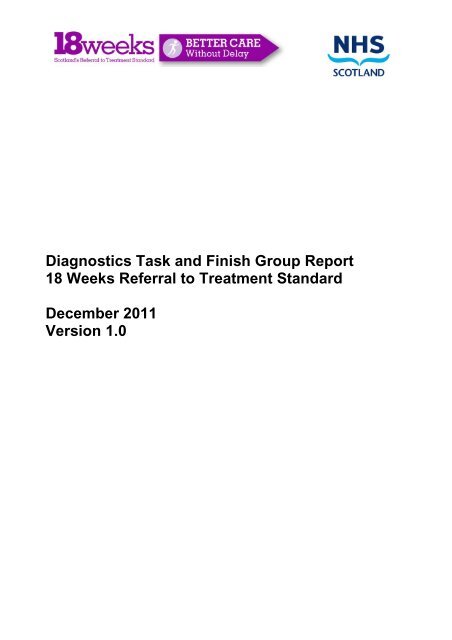
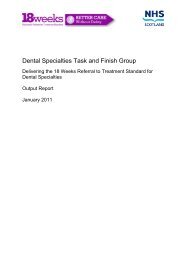
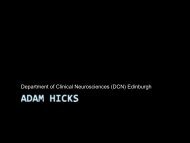
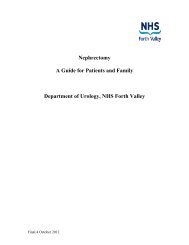
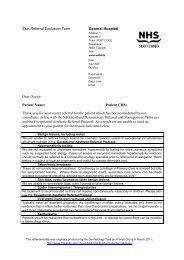
![Dr Matthew Checketts, NHS Tayside [PDF - 6Mb] - 18 Weeks](https://img.yumpu.com/49027155/1/190x143/dr-matthew-checketts-nhs-tayside-pdf-6mb-18-weeks.jpg?quality=85)
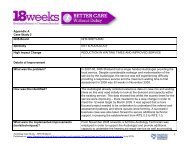
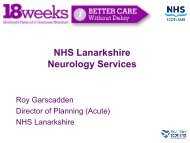

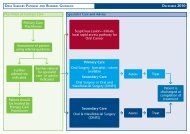


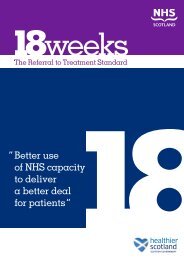
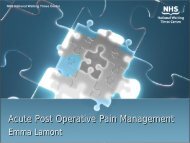
![Mark Sindall, NHS Dumfries and Galloway [PDF - 227Kb] - 18 Weeks](https://img.yumpu.com/30080335/1/190x143/mark-sindall-nhs-dumfries-and-galloway-pdf-227kb-18-weeks.jpg?quality=85)